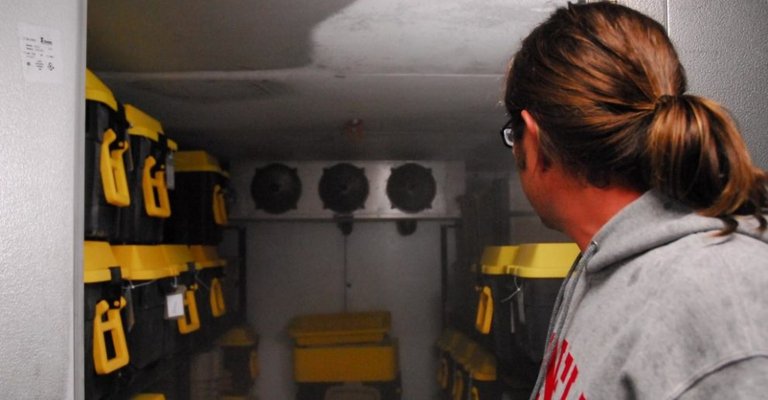
Community meat lockers may have been a thing of the past, but by several accounts they appear to be making a comeback in modern times. Food cultivation, preservation, and sustainability practices that were once a part of the traditional lifestyle of early settlers, are once again finding their way into homes all over America. One of the early sustainable concepts to appear in communities was the meat locker, which were commonplace during the 1940’s.
When frozen food first became available in the 1940’s, there was nowhere to store it. Refrigeration was still in its infancy and very few of them were equipped with a freezer. This created a need that was initially filled by the community meat locker concept; people without freezers at home in their refrigerators needed a place to store the frozen food they had purchased. Butchers and independent grocers were quick to setup cold storage meat lockers next to their existing shops. These community meat lockers were segmented into individual compartments, or bins, most of which were furnished with a lock and key that was given to the individual who rented that particular bin. This allowed customers the ability to retrieve their frozen food products whenever they had the desire to do so.
In the modern age, refrigerators come equipped with freezer space, but it is seldom enough to store a year’s worth of surplus. To accommodate a purchase of bulk meat, an individual must have the ability to store it, normally in a separate stand-alone freezer, which most people do not have, especially if they live in an urban setting such as an apartment, condominium, or townhouse. As such, folks living in limited space conditions seldom consider taking advantage of buying meat in bulk.
Today’s Modern Meat Lockers:
This historic concept was reinvigorated recently by the Finger Lakes Meat Project which operates in New York. This project currently operates two meat lockers; one is in Ithaca and the other on Corning. The success of this project has given others the idea of implementing community based meat lockers in their cities.
It’s no secret that buying in bulk reduces overall cost and saves the consumer money over purchasing the same quantity of meat as individual cuts from a local grocery store chain. Individuals who purchase bulk meat can experience significant savings. For instance, let’s say an individual buys 100 lbs. of beef as individual cuts from regional supermarkets and grocery stores, and the total cost comes to $850.00. If they purchased a quarter of beef in bulk from a local farmer, which is roughly 100 lbs., the total cost would come to $600-$650, saving them $200-$250 on the purchase price. They could then rent a bin from a community meat locker for $5-$10 a month and store their surplus until needed; retrieving cuts once a week for weekly meal prep and storing them in the freezer attached to the refrigerator at home.
Urban residents who are interested in the concept of sustainability, yet whose living conditions prevent them from having a stand-alone freezer of their own on site, will flock to the community meat locker concept. In order for this concept to work however, it will be important to engage in a community outreach program that educates the community on the entire concept from beginning to end. The target audience (people you want to have as renters), will need to be educated on the benefits of buying in bulk and how the community locker system operates; when is the meat locker open for business, how are individual bins accessed, who has access to the meat locker, what theft prevention measures are being taken, etc. If they do not understand these things, the community meat locker concept may be difficult for them to engage with.
Benefits to Local Farmers:
Local farmers who are raising livestock may also find the community meat locker concept to be a profitable side business, or business enhancer. Most livestock farmers sell their bulk meat for far less money per pound than can be found at grocery stores. Local farmers could establish community meat lockers in nearby towns and cities, continue to sell their meat in bulk, and rent out the storage space to those in need of it.
Want More Survival & Preparedness training?
Visit: http://survivalist.com
Really! I had not idea it was making a comeback. I knew about these back in the day but to hear they are making a comeback excites me. Just the possibilities of people becoming self sufficient is so awsome. I live in a small town and managed to get myself an old antique cast iron ice box so I will use that outside in my fenced yard and store what I can in there. Thanks for sharing this information. Keep the posts coming following you.
Very interesting. I have no fridge or freezer at home (not enough solar/battery power to run), I rent space in a friends freezer (pay rent in meat :D) to store meat and plastic bottles of salt ice, which I switch out and then use in a cooler box at home. Good to see community initiatives take shape in the city too.
Urban community meat lockers are a back-to-the-future example of built environment innovation. Developing an expressed requirement for an urban community meat locker would make for a good project based learning (PBL) experience for students in the community through an open-source Built Environment Innovation Challenge. Feel free to check out and use this open source content posted on GitHub. Questions, comments, and critiques of it are welcome.
Do you know if any of these community meat lockers allow for dry aging of some of the better cuts in proper aging conditions. That would seem to be a real value added benefit. Good article!